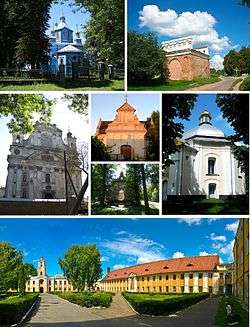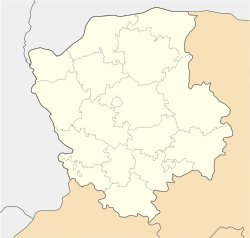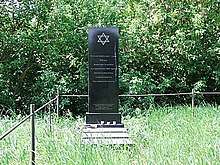Olyka
Olyka (Ukrainian: Оли́ка, Polish: Ołyka, Yiddish: אליק Olik) is an urban-type settlement in Kivertsi Raion, Volyn Oblast, Ukraine. It is located east of Lutsk on the Putilovka Rriver. Its population is 3,130 (2015 est.)[1].
Olyka Оли́ка | |
|---|---|
 | |
 Coat of arms | |
 Olyka  Olyka | |
| Coordinates: 50°43′0″N 25°49′0″E | |
| Country | |
| Oblast | |
| Raion | Kivertsi Raion |
| The first mention | 1149 |
| Magdeburg law | 1564 |
| Area | |
| • Total | 4,91 km2 (190 sq mi) |
| Population (2015) | |
| • Total | 3,130[1] |
| • Density | 637/km2 (1,650/sq mi) |
| Time zone | UTC+2 (EET) |
| • Summer (DST) | UTC+3 (EEST) |
| Postal code | 45263 |
| Area code(s) | +380 3365 |
History

.jpg)
The village of Olyka was founded in the early Middle Ages as one of the villages belonging to the Kievan Rus'.[2] It was first mentioned in 1149 in the Hypatian Chronicle.[2][3] In the 14th century it was conquered by Grand Duchy of Lithuania.[3]
Under the Grand Duchy of Lithuania, the village grew rapidly and became a centre of local magnates, initially the family of Kiška and, after 1533, the Radziwills.[3] In 1548 Mikolaj Radziwill the Black became Duke of Olyka.[4] In 1569, Olyka became part of Poland after the Union of Lublin.
In the second half of the 16th century, during the Protestant Reformation, the town became one of the most important centres of Calvinism in the Polish-Lithuanian Commonwealth. Its growth was halted by the Chmielnicki Uprising of 1648, during which the town was captured by Cossacks, plundered and burnt.[2][3] However, it was soon rebuilt and in 1654 it received city rights. As the main seat of one of the branches of the influential Radziwill family, Olyka became one of the most important political and trade centres of all of Volhynia.[5][6]
In the Third Partition of Poland (1795), the town was annexed by the Russian Empire and became part of the Volhynian Governorate. In the 19th century, it continued to play a role as a centre of wood and grain trade. During World War I in 1915 and 1916, the area was a scene of heavy fighting between the forces of Russia and Austria-Hungary.[7] After the Polish-Bolshevik War, the town was restored to Poland as part of Wołyń Voivodeship, and the local palace was refurbished.
Following the Polish Defensive War of 1939 and the Nazi-Soviet Alliance, the town was occupied by Soviet Union forces. After Operation Barbarossa, when Germany attacked the Soviet Union, the German occupation started and lasted until 1944. Accused of helping Ukrainian partisans, Olyka was attacked and deeply damaged by Organization of Ukrainian Nationalists (OUN) forces. That year the Red Army liberated what was left of Olyka.[8]
After World War II the area was annexed by the Soviet Union and incorporated into the Ukrainian SSR. Since 1991 it is a part of independent Ukraine.
Notable landmarks

- Olyka Castle (surrounded by Radziwill Fortress) – late 16th century, expanded in the mid-18th century, damaged after 1945, restored after 1990[3][9]
- The Calvinist Church, converted in 1580 to a Catholic church of the Holy Trinity, and from 1592 dedicated to Apostles Peter and Paul[2]
- Roman Catholic Collegiate Church of the Holy Trinity (1635–1645)[2][3][10]
- The Lutsk Gate of the city (1630s)[3]
- Orthodox Christian Church of the Presentation in the Temple (1784)[2][3]
- Orthodox Christian Church of the Holy Trinity (1886)[2]
Other Radziwill estates
- Mir Castle
- Niasvizh Castle
Jewish presence
Pre-World War II
Jewish presence in Olyka dates back to the 16th century, and in the late 17th century the Jewish community became one of the largest in the Volhyn Region.[2][8]
After the Cossack Chmielnicki Uprising of 1648, 20 out of 30 Jewish households survived.[2] It was believed that the prayer by Rabbi David HaLevi Segal miraculously saved the Jewish and non-Jewish citizens of Olyka from the Cossacks' assault of 1651.[2][11]
Olyka was the cradle of the Olyker Hasidic dynasty that was founded by the famous Rabbi Hersh Leib Landa the first Olyker rebbe. He was followed by his son Rabbi Yosef (Yoseph) Dovid, who was followed by his son Rabbi Mordechai (he authored a book called Gedulas Mordechai). He was followed by his son Rabbi Shimon Shloima (he authored a book called Shekel Hakodesh, and was father-in-law of Rabbi Yochanan Perlow of the Karliner Dynasty), who was followed by his son Rabbi Alter Yosef (Yoseph) Dovid.[12][13]
In 1897 a total of 2,606 people – 50 percent of the total Olyka population – were Jews, and that amount increased when many Jewish refugees from nearby towns fled to Olyka during World War I.[8] According to the 1921 census, the number of Jews living in Olyka had decreased to 2,086 individuals.[14]
The Holocaust

Olyka's large Jewish community was completely destroyed during the Holocaust, including Nazi persecutions at the site of the Radziwill Fortress/Olyka Castle. It is an important place of Jewish memory.[2][15][16][17][18][19] Rabbi Alter Yosef Dovid Landa and his family perished.[12]
Following the September 1939 Ribbentrop-Molotov Pact and German-Soviet Occupation of Poland, many Jewish refugees from central and western Poland settled in Olyka in the fall of 1939, as did 60 Jewish refugees from Czechoslovakia.[8][14] Jewish organizations and institutions were forced to disband.[8] After the German invasion of Ukraine in June 1941, as part of Operation Barbarossa, the German 6th Army entered Olyka, destroyed houses, killed 100 Jews, and kept the remaining Jews in an open ghetto.[8][20] Around 150 Jews evacuated eastward; most Jews stayed in the ghetto.[14] Jews and non-Jewish Ukrainians continued to trade goods and food in and around the ghetto; for example, an Olyka ghetto Jew traded his house for sixteen kilograms of rye due to famine.[21] As part of the Einsatzgruppen aktion of August 1941, 720 Jews, including Rabbi Alter Yosef Dovid Landa, were killed at the Olyka Castle and at the town's Jewish cemetery towards Czemeryn.[8][14][20][22][23][24]
In March 1942, Jews from surrounding villages were brought into Olyka, and a closed ghetto was created with barbed-wire fence to imprison those inside.[8][14][21] More than 4,000 Jews were shot to death by Nazi and Ukrainian forces in the summer of 1942, in and around the Olyka ghetto, Radziwill Fortress, Olyka Castle, and surrounding areas.[8][14][18][25] Monuments outside Olyka commemorate this massacre.[18][19] The mass grave is located on the road to Zhornische (Żorniszcze).[22][24][26][27]
Accounts vary as to the total number of Jews in and around Olyka who had died by the time the Olyka ghetto was liquidated in July/August 1942. Given the circumstances of Nazi massacres, it has been difficult to accurately count the dead. Most reports state the total amounted to 5,220 to 5,673 Jews.[14][28] In early 1943, 130 remaining Jewish artisans remaining in the ghetto were shot to death.[8][14][22] Although Olyka's Great Synagogue was intact after the summer 1942 ghetto liquidation, it was destroyed by war's end.[2] Israel's Holon Cemetery has a monument in memory of those Jews of Olyka and its surroundings, who died in the Holocaust.[29]
Fewer than 30 Jews escaped to the forest in the summer of 1942. Of those survivors, 23 men created a partisan unit with 30 Jews already outside the village. They joined the underground resistance in the region against the Nazis, and a small number survived after early 1943.[30]
Population
| Year | Pop. | ±% |
|---|---|---|
| 1959 | 3,905 | — |
| 1970 | 3,965 | +1.5% |
| 1979 | 4,199 | +5.9% |
| 1989 | 3,741 | −10.9% |
| 2001 | 3,255 | −13.0% |
| 2010 | 3,141 | −3.5% |
| 2014 | 3,138 | −0.1% |
| 2017 | 3,083 | −1.8% |
| Source: Census data | ||
According to the last census from 2001, there were 3,255 people living in Olyka. It is estimated 3,083 people lived there as of 2017. [31][32]
Climate
The climate in Olyka is cold and temperate, with significant rainfall that occurs mostly in July.[33]
| Climate data for Olyka, Ukraine | |||||||||||||
|---|---|---|---|---|---|---|---|---|---|---|---|---|---|
| Month | Jan | Feb | Mar | Apr | May | Jun | Jul | Aug | Sep | Oct | Nov | Dec | Year |
| Average high °C (°F) | −2.2 (28.0) |
−1.2 (29.8) |
3.5 (38.3) |
12.4 (54.3) |
19 (66) |
22.7 (72.9) |
23.9 (75.0) |
23 (73) |
18.3 (64.9) |
12.1 (53.8) |
5.2 (41.4) |
0.1 (32.2) |
11.4 (52.5) |
| Average low °C (°F) | −8.1 (17.4) |
−7.3 (18.9) |
−3.7 (25.3) |
2.7 (36.9) |
8.1 (46.6) |
12 (54) |
13.3 (55.9) |
12.2 (54.0) |
8.3 (46.9) |
3.8 (38.8) |
0 (32) |
−4.8 (23.4) |
3.0 (37.5) |
| Average precipitation mm (inches) | 31 (1.2) |
30 (1.2) |
26 (1.0) |
37 (1.5) |
58 (2.3) |
71 (2.8) |
80 (3.1) |
66 (2.6) |
53 (2.1) |
39 (1.5) |
39 (1.5) |
38 (1.5) |
568 (22.3) |
| Source: Climate-Data[33] | |||||||||||||
Notable people
- Janusz Chodnikiewicz[34] (1936 – ), film director, producer
- Henry Orenstein (c. 1923 – ), toymaker, poker player, author, and entrepreneur (resided in Olyka 1939–1941)
- Albrycht Stanisław Radziwiłł (1595 – 1656), Polish–Lithuanian Commonwealth politician, Lithuanian chancellor
- Michał Kazimierz "Rybeńko" Radziwiłł (1702 – 1762), equestrian, hetman, starost
References
- "Чисельність наявного населення України (Actual population of Ukraine)" (PDF) (in Ukrainian). State Statistics Service of Ukraine. Retrieved 1 July 2016.
- Kravtsov, Sergey R. (2008). "A Synagogue in Olyka: Architecture and Legends". In Bronner, Simon (ed.). Jewish Cultural Studies, vol. 1, Jewishness: Expression, Identity, and Representation. Oxford: Littman Library of Jewish Civilization. pp. 58–84.
- "Olyka". Internet Encyclopedia of Ukraine. Retrieved 26 July 2017.
- Narbutas, Sigitas. "Mikołaj Radziwiłł the Black". Lithuanian Publishers Association. Retrieved 26 July 2017.
- Stecki, Tadeusz J. (1887). "Radziwiłłowska Ołyka". Przegląd Powszechny, vol. 9 (PDF). Kraków.
- Clebowski, Bronisław; Walewski, Władysław, eds. (1888). Słownik geograficzny Królewstwa Polskiego i innych krajów słowiańskich [Geographical dictionary of Polish Kingdom and other Slavic countries], vol. 7. Warsaw. pp. 527–28.
- The New York Times Index, Volume 4, Issue 2. New York Times. New York. 1916. p. 112.
- "Olyka". Yad Vashem. Retrieved 25 July 2017.
- "Wołyń, Podole i Ziemia Czerwieńska, Ołyka (Gubernija Wołyńska)" [Volhynia, Podole and Czerwieńska Land, Ołyka (Volyn Governate)] (in Polish). Galeria Malarstwa Polskiego. Archived from the original on 11 December 2002.
- "Image at Galeria Malarstwa Polskiego".
- Biber, Menachem-Mendel (1903). Yalkut Menahem. Vilnius. pp. 5–6.
- Spector, Shmuel (1990). "The History of the Jews of Volhynia". Encyclopaedia of Jewish Communities, Poland (Volume V). Jerusalem: Yad Vashem. pp. 1–25.
- "Rabbi Shimon Shloima of Landa". Geni. Retrieved 26 July 2017.
- Dean, Martin (2012). Encyclopedia of Camps and Ghettos, 1933–1945 Volume II Ghettos in German-Occupied Eastern Europe Part B. Bloomington, IN: United States Holocaust Memorial Museum/Indiana University Press. pp. 1435–1436. ISBN 978-0253355997.
- Livneh, Natan (1972). Pinkas ha-kehila Olyka. Sefer yizkor (Memorial book of community of Olyka). Tel Aviv: Olyka Society.
- Grinstein, Michael (1973). Never Again. Los Angeles, CA. OCLC 45643150.
- "Written Testimonies". Yad Vashem. Retrieved 11 July 2017.
- "YIU Field Course in Ukraine". Yahad-In Unum. Retrieved 11 July 2017.
- "Commemoration of Jewish Victims". Yad Vashem. Retrieved 25 July 2017.
- "Holocaust Encyclopedia: Invasion of the Soviet Union, June 1941". United States Holocaust Memorial Museum. Retrieved 16 July 2017.
- Sterling, Eric (2005). Life In The Ghettos During The Holocaust. Syracuse, NY: Syracuse University Press. p. 135. ISBN 978-0815608035.
- "Online Guide of Murder Sites of Jews in the Former USSR: Wolyn region (until 1939 Poland)". The International Institute for Holocaust Research/Yad Vashem. Retrieved 16 July 2017.
- "Jewish Cemetery". Yad Vashem. Retrieved 25 July 2017.
- "Execution Sites of Jewish Victims: Olyka". Yahad-In Unum. Retrieved 16 July 2017.
- "Radziwill Fortress". Yad Vashem. Retrieved 25 July 2017.
- "International Jewish Cemetery Project". International Association of Jewish Genealogical Societies. Retrieved 16 July 2017.
- "Żorniszcze Village". Yad Vashem. Retrieved 16 July 2017.
- Pohl, Dieter (2008). "I. The Murder of Ukraine's Jews under German Military Administration and in the Reich Commissariat Ukraine". In Ray Brandon; Wendy Lower (eds.). The Shoah in Ukraine: history, testimony, memorialization. Indiana University Press. ISBN 978-0-253-35084-8.
- "A stone monument in memory of the Jews of Olyka and its surroundings, who perished in the Holocaust". Ghetto Fighters' House Archives. Retrieved 11 July 2017.
- Arad, Yitzhak (2010). In the Shadow of the Red Banner: Soviet Jews in the War Against Nazi Germany. Gefen Publishing House Ltd. p. 326. ISBN 978-965-229-487-6.
- "Olyka in Kivėrcivs'kyj rajon (Volhynia)". citypopulation.de. Retrieved 21 August 2017.
- "Cities & Towns of Ukraine". Tim Bespyatov. Retrieved 30 July 2017.
- "Climate: Olyka". Climate-Data. Retrieved 30 July 2017.
- Janusz Chodnikiewicz